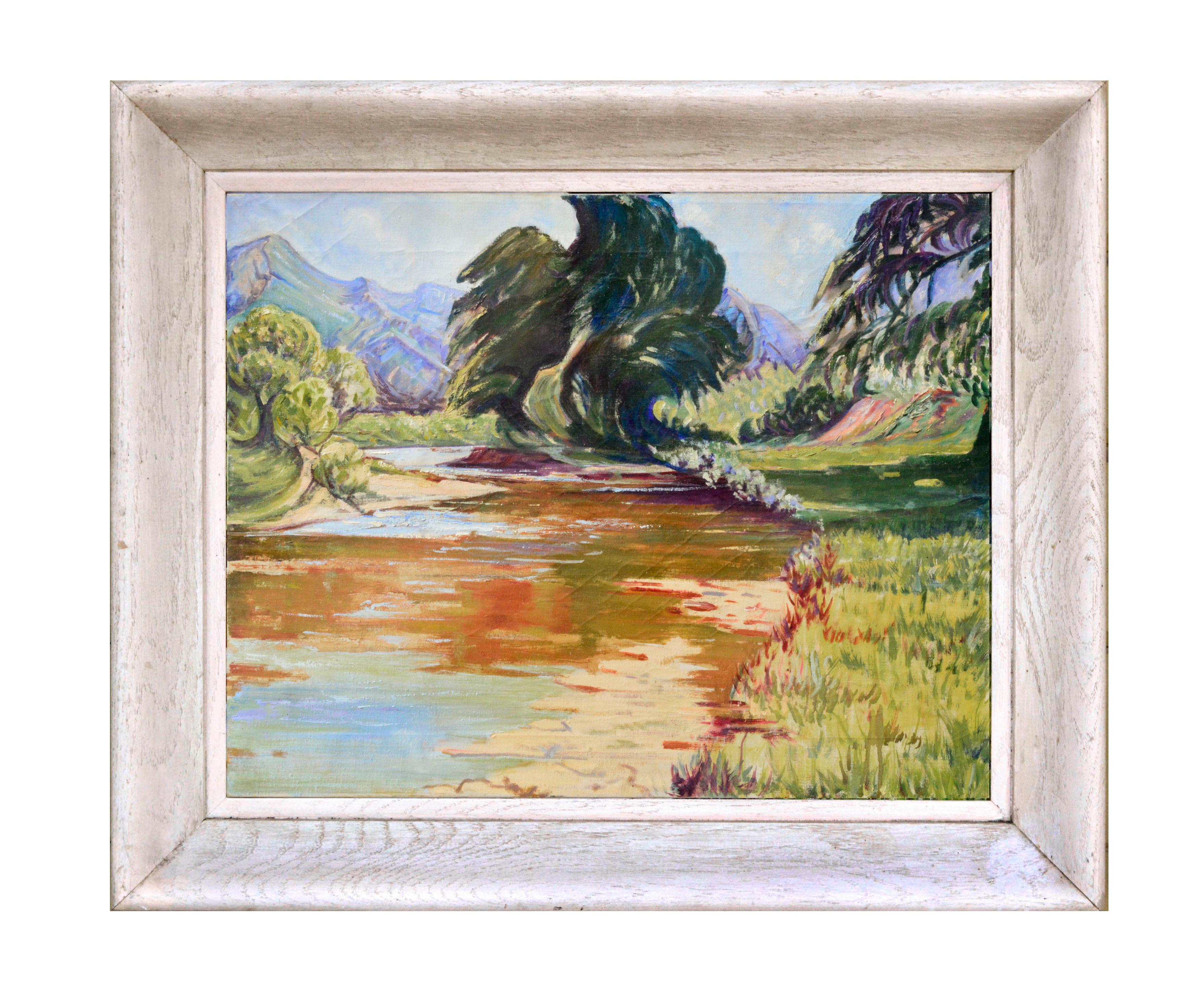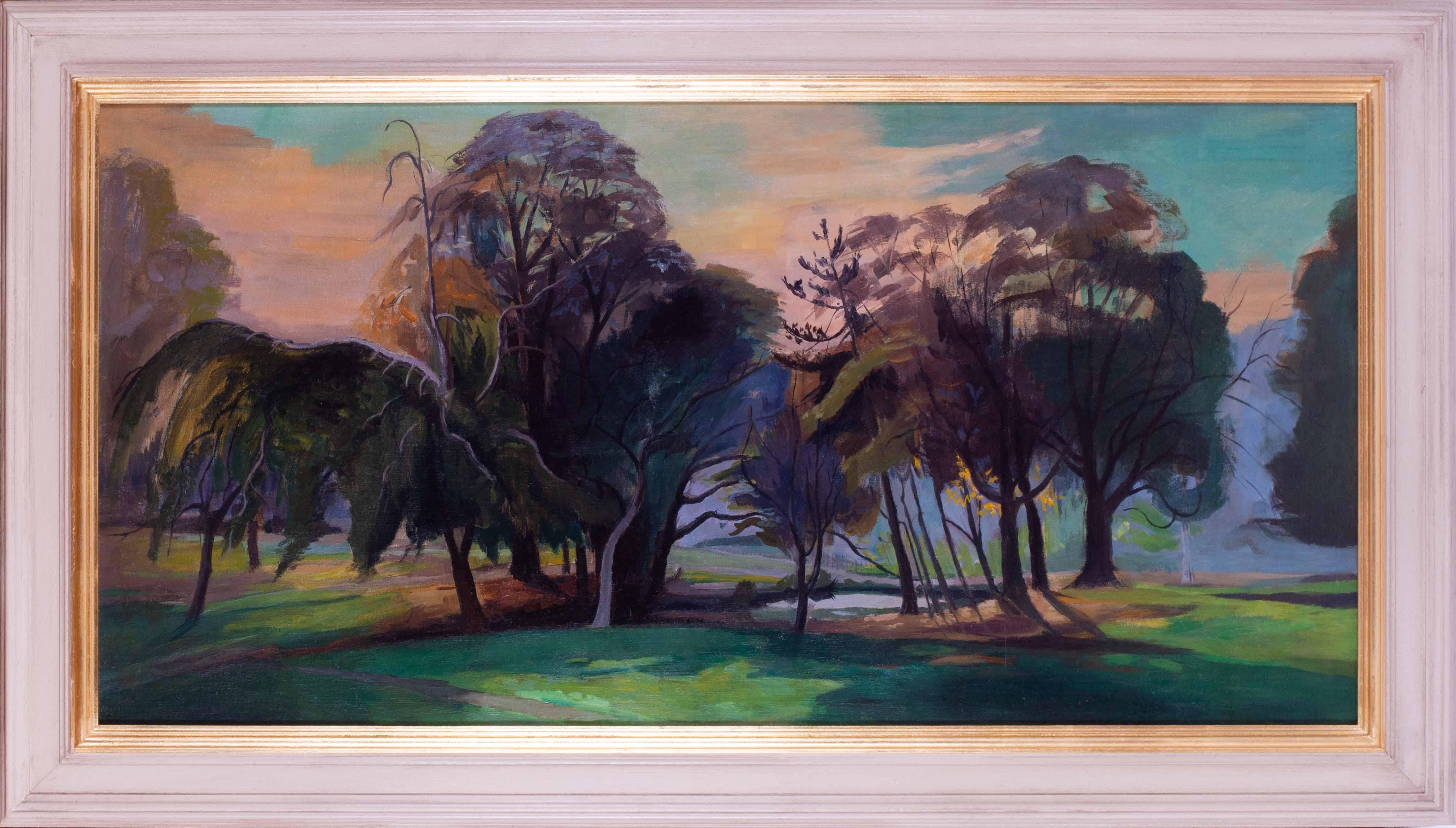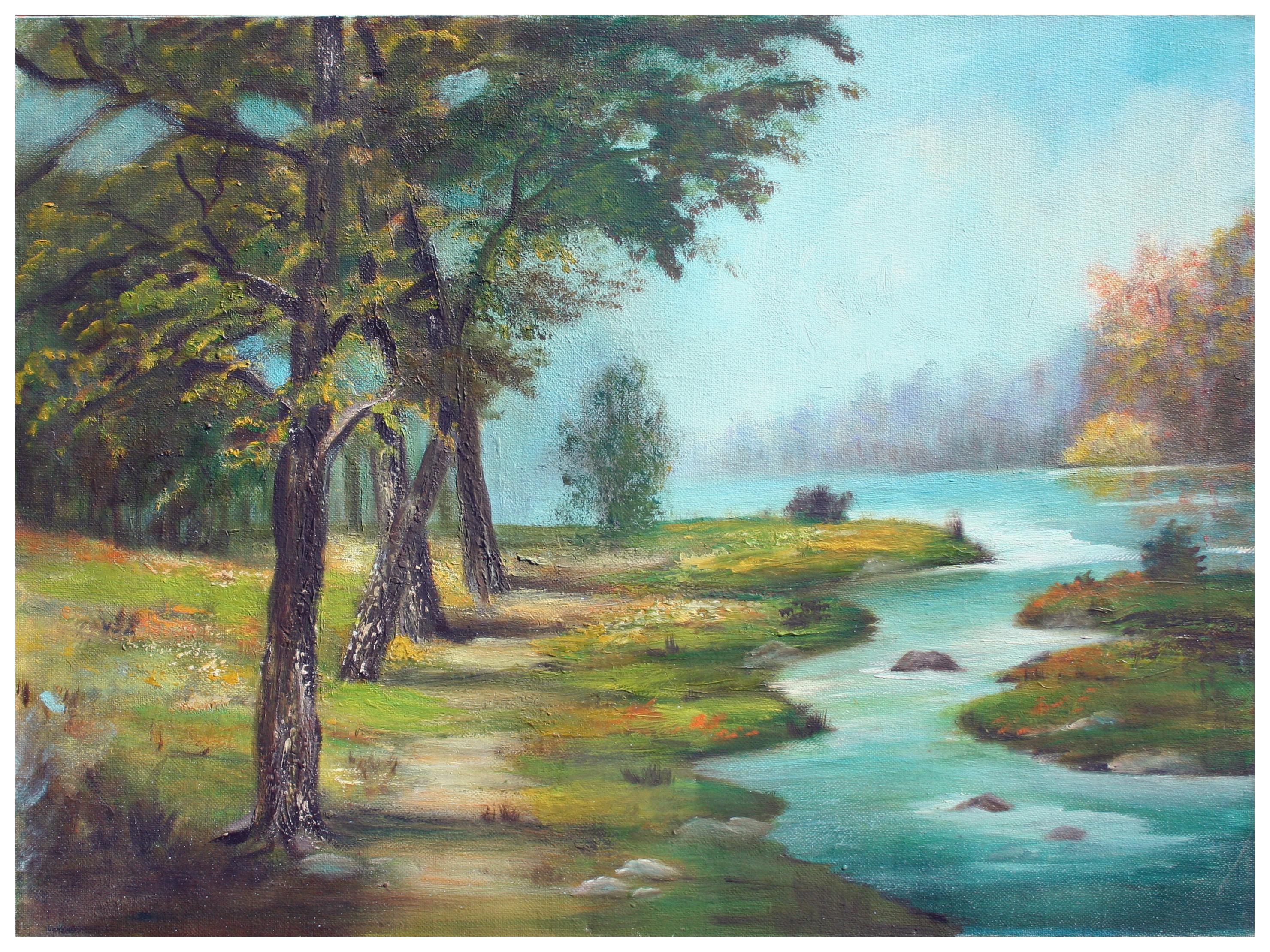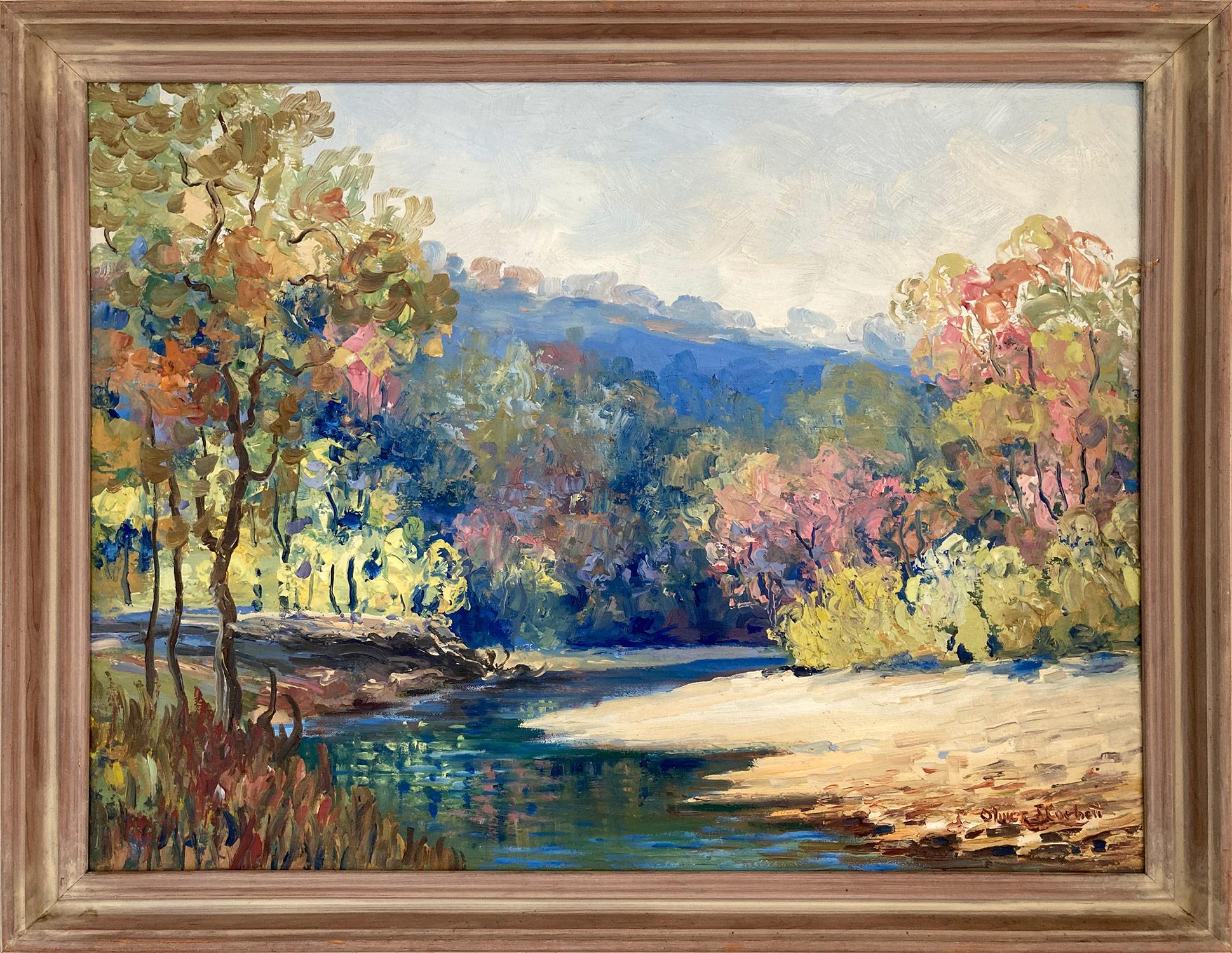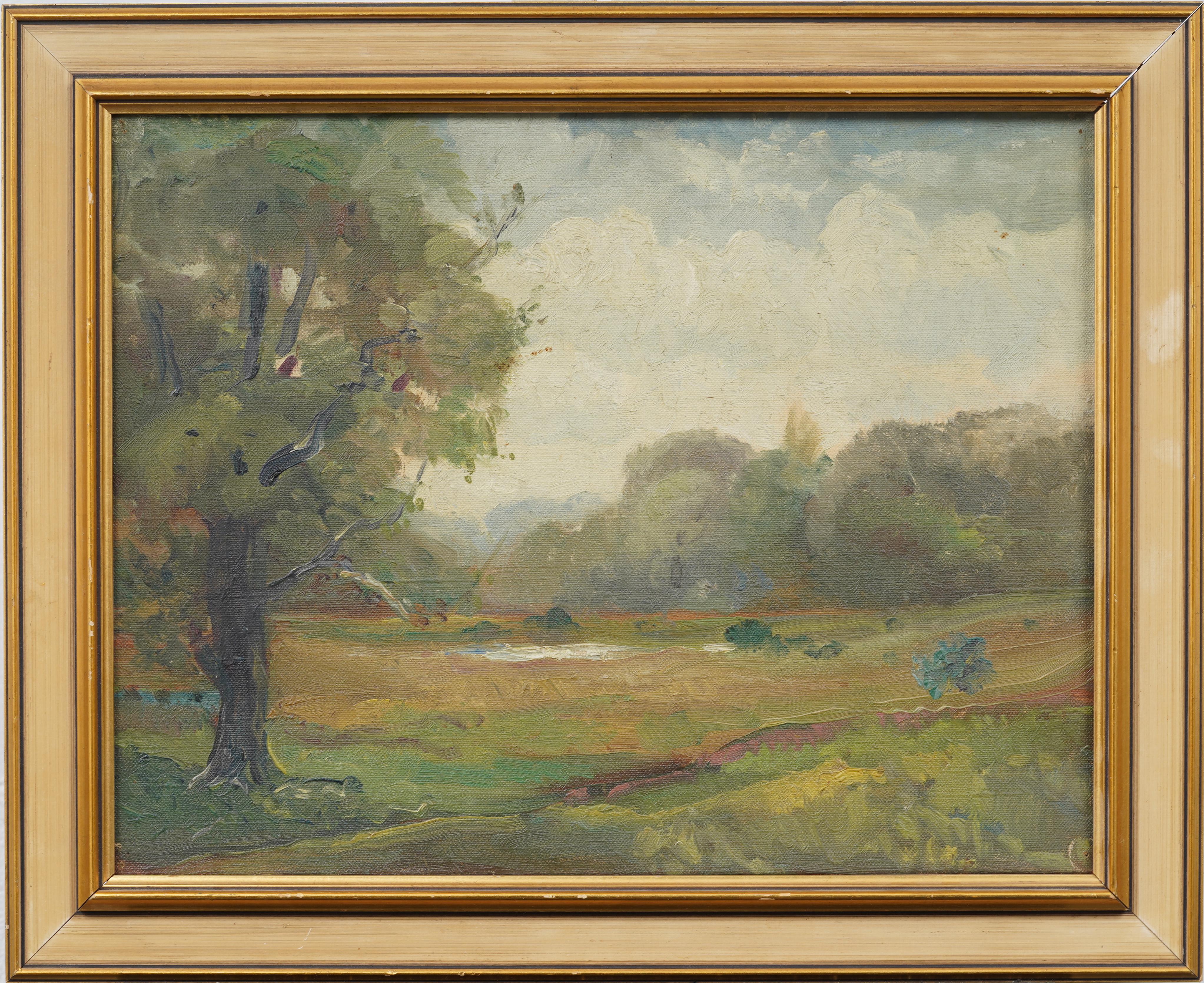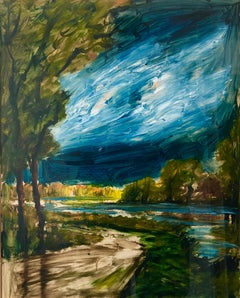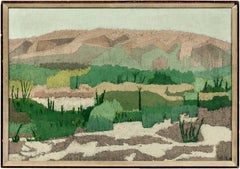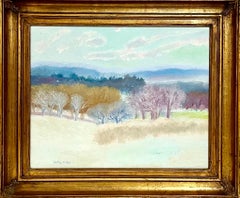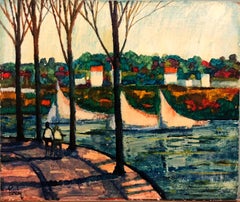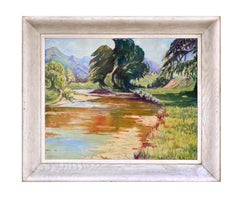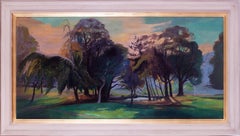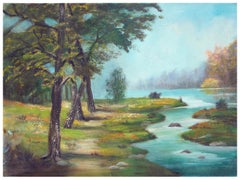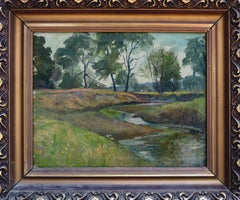Items Similar to Early Modernist River Landscape with Trees and Mountains WPA artist
Want more images or videos?
Request additional images or videos from the seller
1 of 6
Maurice KishEarly Modernist River Landscape with Trees and Mountains WPA artist1931
1931
$3,800
£2,886.41
€3,326.12
CA$5,351.34
A$5,932.75
CHF 3,117.89
MX$72,607.17
NOK 38,939.32
SEK 36,548.44
DKK 24,827.45
About the Item
In artist's hand painted frame. signed and dated.
Genre: Modern
Subject: Landscape
Medium: Oil
Surface: Canvas
Country: United States
Dimensions w/Frame: 23" x 30.25"
The imagery of Maurice Kish (1895-1987), whether factories or carousels, reliably subverts expectations. His vision hovers just around the unraveling edge of things, where what is solid and clear becomes ambiguous. He is fascinated, often delighted, by the falling apart. This unexpected, fresh perspective results in oddly affecting pictures of a now long-gone New York.
Born Moishe in a town called Dvinsk, Russia (what is now Daugavpils, Latvia), Kish came with his family to New York when he was in his teens. The family settled in Brownsville, and for the rest of Kish’s life Brooklyn remained his home, though he moved from one neighborhood to another. He was close to his parents, who recognized his talent and supported his desire to become an artist.
Kish attended the National Academy of Design as well as Cooper Union. His fellow students included many other immigrants and children of immigrants who were particularly receptive to the Modernism coming from Europe. As his career progressed, Kish himself applied different strains of Modernism to different purposes. For him, the story was held above all else.
For years, Kish used the skills he acquired in art school to earn his living at a Manhattan glass factory where he painted floral designs on vases. During the Depression, Kish became a WPA painter in the Federal Art Project (FAP). FAP artists were given a mandate to create works that celebrated labor. The artists tended to be socially progressive, as Kish certainly was. Kish's work from this period, with its dark colors and rolling clouds, reveals the influence of Social Realists like Thomas Hart Benton. Apparent, too, is Kish's interest in the urban monumentality of Charles Sheeler. Kish's structures, however, lack Sheeler's almost dehumanized precision. Rather than the soulless, sleek machines of a typical modern urban dystopia, Kish's factories are shaggy old beasts as worn out as the laborers who troop through their doors. In End of Day's Toil, now at the Smithsonian, the viewer feels some affection for that rambly grandfather of a building all the tired small workers are leaving behind.
Much of Kish's work, for the FAP and elsewhere, undermines received truths in a similar way. Some early works with themes from Yiddish culture are overtly humorous: a painting of a big jolly wedding guest, looking invitingly over her shoulder; a big fiddler on a small roof. Later, the humor becomes more ironic and reflective. In another work, the rather imposing organ grinder of the late 1930s looms above a child, yet his intermediary the cockatoo is bright and appealing, and offers the girl a fortune with his beak. This could read as an allegory for capitalism as easily as a straightforward colorful street scene. A small painting of a snowy day in Washington Square gives a bird's eye view of people bent against the wind walking alone or in pairs. The huge triumphal arch at the middle of it has no connection to their movements or their lives. Kish makes its size and centrality a quiet joke about the futility of grandiose gestures. Like the buildings in his FAP works, the arch has a personality. It is a landmark that looks a bit lost.
A favorite location for Kish was Coney Island. For the laborers of the city, this was a place of great freedom and possibility. There were no bosses! Anyone could go to ride the rides and swim in the sea. For Kish, Coney Island, and especially Luna Park, became a place richly symbolic of workers’ rights. For the dreamlike paintings he set there, Kish looked past the Social Realists to the Expressionists. His colors are brilliant and his lines are wild. These images, joyfully unrestrained, give full voice to an anarchic vision merely hinted at in other works. If the structures of the earlier pictures came further out of the background than expected, these Coney Island structures completely take over the scene.
Kish made several variations on the theme of the carousel as a site of revolution. In the moonlight, the horses have broken from their poles and spin away from the calm center. The workers have come to manic life, have released themselves from the yoke of labor and have abandoned their master, the merry-go-round. They escape to different corners of the pleasure park, dance together and ride the ferris wheel. One horse pretends to be a ticket seller. It is another allegory, one that depicts a worker's holiday paradise in carnival fashion.
A painter who embraced ambiguity, Kish was himself a man who occupied many worlds simultaneously. Even during the period when he had shows at prestigious galleries and belonged to several artists' groups, he identified most strongly as an outsider, a Yiddischer. He wrote poetry in Yiddish throughout his life. In 1968, he published a volume of fifty years of these poems, Di Velt ist Mayn Lid (The World is My Song) in Yiddish, with no English translation, for his peers. Kish also translated English-language poetry into Yiddish and acted as a guide to help other Yiddish writers. Long after the art organizations ceased to provide meaning and fulfillment, Kish was a devoted member of the Yiddish Culture Association.
In addition to painting and poetry, Kish was a dancer who taught during the summers at various Jewish resorts in the Catskills. Small but lithe, he also spent some years as an amateur boxer. Well into his eighties, Kish was proud of the quality of his handball game.
By the 1940s, Kish’s career was going well, but his descriptive style of working began to fall out of fashion, supplanted by a more formal Abstraction. Kish was never able to support himself solely through his art, yet in the midst of all of his other activities, Kish continued to create his distinctive images of an immigrant's New York. He departed far from the mainstream, and in later years, seldom showed his work, preferring to keep it for himself (although he sometimes traded paintings for rent).
Of making art, Kish said, "It is a sacred mission to enrich, to elevate and to make our lives more complete." His works, though frequently playful, encourage a second look at ordinary things. His irreverence elevates by revealing flaws where his audience, all workers and outsiders of a kind, can get a purchase. Kish's art fondly celebrates the beauty of the irregular.
- Creator:Maurice Kish (1895-1987, American)
- Creation Year:1931
- Dimensions:Height: 23 in (58.42 cm)Width: 30.25 in (76.84 cm)
- Medium:
- Movement & Style:
- Period:
- Condition:
- Gallery Location:Surfside, FL
- Reference Number:1stDibs: LU38211979922
About the Seller
4.9
Platinum Seller
Premium sellers with a 4.7+ rating and 24-hour response times
Established in 1995
1stDibs seller since 2014
1,801 sales on 1stDibs
Typical response time: <1 hour
- ShippingRetrieving quote...Shipping from: Surfside, FL
- Return Policy
Authenticity Guarantee
In the unlikely event there’s an issue with an item’s authenticity, contact us within 1 year for a full refund. DetailsMoney-Back Guarantee
If your item is not as described, is damaged in transit, or does not arrive, contact us within 7 days for a full refund. Details24-Hour Cancellation
You have a 24-hour grace period in which to reconsider your purchase, with no questions asked.Vetted Professional Sellers
Our world-class sellers must adhere to strict standards for service and quality, maintaining the integrity of our listings.Price-Match Guarantee
If you find that a seller listed the same item for a lower price elsewhere, we’ll match it.Trusted Global Delivery
Our best-in-class carrier network provides specialized shipping options worldwide, including custom delivery.More From This Seller
View AllMid Century Modernist French Painting Landscape With Forest, River, Path
By Roger Etienne
Located in Surfside, FL
Beautiful gouache on paper, Moody atmospheric landscape in shades of black, blue green and gold by French artist, Roger Etienne Everaert Ret, signed on top right.
Roger Etienne, Fren...
Category
20th Century Modern Landscape Paintings
Materials
Gouache
Abstract Landscape 1954 American Modernist from Paul Rosenberg Gallery
By Raymond Mintz
Located in Surfside, FL
Label verso from Paul Rosenberg Gallery. (this was 600$ in 1954!) 18 X 26 without frame. 19 X 27.75 with frame
Raymond was born in Clifton, New Jersey, in 1925, of German descent.
...
Category
Mid-20th Century Modern Landscape Paintings
Materials
Oil, Board
Modernist Oil Painting Bucolic Valley Woods Landscape Ralph Della Volpe
Located in Surfside, FL
RALPH DELLA-VOLPE (1923-2017)
Fine Art Painter, American Contemporary
The Valley
Oil on canvas
Hand signed lower left and again to stretcher and verso
16 x 20 inches. frame dimensions: 22 1/4 x 26 inches, wood frame
Provenance: The Estate of the artist Ralph Della Volpe
TRAINING:
National Academy of Design
The Art Students League, NYC
Ralph Eugene Della-Volpe's semi-abstract paintings of often simplified, minimalist, beach scenes and anonymous portraits "convey profound awareness of mood and character", and his paintings are hardly as literal as they may first appear (Arts Magazine. "New York Exhibitions". 1965). His brightly-colored, light-infused, ornamental compositions bring together aspects of many modernist art movements including Fauvism, Impressionism, Symbolism, and abstraction. Della-Volpe first studied painting at the prestigious National Academy of Design before joining the Army during World War II. As a soldier, the artist saw action on Utah Beach, winning a Purple Heart, and his experiences undoubtedly affected his later artistic style. The Fauvist "coloristic exuberance" found in the works beginning in the mid 1960's, with their vibrant fuschias and yellows, seem to offset what could be an otherwise solemn tone to many of his works at the time. Upon his return from military service, Della-Volpe’s style evolved significantly. In the years following the second world war, his work was solemn, imbued with a quiet darkness. Over time, this darkness faded: by the 1950s, influenced by his time at the Art Students League, his oeuvre was overtaken by the tenants of Abstract Expressionism. Paintings from this period boast bold brushwork, energetic compositions, and strong color. Although the next decade saw Della-Volpe trade expressionist abstraction for figuration, his love of color continued to shine through his work.Della-Volpe took a teaching position as the first artist-in-residence at Bennett College in Millbrook, New York where he remained for 28 years, serving as chairman of the Art Department for most of that time. Obviously influenced by impressionism 's preoccupation with the treatment of light, Della-Volpe's own works have a "faultless tonal quality, with its sense of failing light—the areas of silvery gray deepening into rosy tans" (Arts Magazine. "In the Galleries". 1960). Della-Volpe has exhibited widely throughout his career and has lectured on art at colleges, universities, and galleries across the country.
SOLO SHOWS:
Hotchkiss Library, Sharon, Conn
Millbrook Library, Millbrook,NY
Gregory James Gallery...
Category
20th Century Fauvist Abstract Paintings
Materials
Canvas, Oil
River Walk, American Modernist Oil Painting Landscape with River and Boats
By Donald Roy Purdy
Located in Surfside, FL
Genre: Impressionist
Subject: marine landscape
Medium: Oil
Surface: Board
Country: United States
Dimensions: 20X24
Donald Roy Purdy is an American painter whose work evolved through...
Category
20th Century Impressionist Figurative Paintings
Materials
Oil, Board
Simka Simkhovitch WPA Artist Oil Painting American Modernist Landscape Pond Tree
By Simka Simkhovitch
Located in Surfside, FL
Simka Simkhovitch (Russian/American 1893 - 1949)
This came with a small grouping from the artist's family, some were hand signed some were not.
These were studies for larger paintin...
Category
1930s American Modern Landscape Paintings
Materials
Oil, Board
American Woman Artist Modernist Large Oil Painting Cubist Influenced Landscape
By Lena Gurr
Located in Surfside, FL
A beautiful wooded landscape scene with houses and trees.
Painted on a masonite board. hand signed lower right. with framers label verso.
Framed to 40 X 55 inches. 33 X 48 without the frame and mat.
It is not dated.
Lena Gurr (1897–1992), was an American woman artist who made paintings, prints, and drawings During the course of her career Gurr's compositions retained emotional content as they evolved from a naturalistic to a semi-abstract cubist style. Born into a Russian-Jewish Yiddish speaking immigrant family, she was the wife of Joseph Biel, also Russian-Jewish and an artist of similar genre and sensibility. Gurr used Lena Gurr as her professional name. After marrying Joseph Biel she was sometimes referred to as Lena Gurr Biel. Biel had been born in Grodno, Poland (later absorbed into Russia) and had lived in England, France, and Australia before coming to New York. An artist, he specialized in landscape paintings and silkscreen printing as well as photography. He studied art at the Russian Academy in Paris. After immigrating to the United States, he studied under George Grosz at the Arts Students League.
Gurr was born in Brooklyn and, apart from brief stays in Manhattan and in Paris, lived there her whole life. This painting bears the influence of Lyonel Feininger an influential German American artist. Gurr began studying art at a young age. In 1919 she studied painting and printmaking at the Educational Alliance Art School and between 1920 and 1922 she won a scholarship to attend the Art Students League where she took classes with John Sloan and Maurice Sterne.
In 1926 and 1928 Gurr participated in group shows at the Whitney Studio Club in Greenwich Village and in 1928 she also participated in the 12th annual exhibition of the Society of Independent Artists at the Waldorf Roof in New York. (Reviewing this show, Helen Appleton Read, the critic for the Brooklyn Daily Eagle, said "I made three discoveries on my first visit, Thomas Nagel, Eugenie McEvoy and Lena Gurr with two figure compositions which have something of Marie Laurencin or Helene Perdriat quality of naive sophistication.") The Waldorf Roof was a set of rooms on the top floor of the Waldorf Astoria Hotel, one of which had glass sides and a glass roof. The rooms were used for concerts, dances, benefits, and exhibitions.From 1929 to 1931 Gurr took a leave of absence from her teaching position to travel in France with Joseph Biel, an artist whom she had met while studying at the Art Students League. They spent time in Nice and Mentone but mainly in Paris.
During the early months of 1931, while she was still abroad, her work appeared in group exhibitions held at the R. H. Macy department store and the Opportunity Gallery (opened by Gifford Beal). In 1932 she participated in three shows: a solo exhibition at the Brooklyn Museum, an annual exhibition of the New York Society of Women Artists, ( Its first president was Marguerite Zorach. Founding members included Agnes Weinrich, Anne Goldthwaite...
Category
Mid-20th Century American Modern Landscape Paintings
Materials
Oil, Panel
You May Also Like
Mid Century River Mountain Valley Oasis Landscape
Located in Soquel, CA
Vibrant landscape of a calm river with colorful reflections winding through a lush valley of grasses and trees, with blue and purple mountains in the background, by an unknown artist...
Category
1950s American Impressionist Landscape Paintings
Materials
Canvas, Oil
Woodland pond landscape painting by female 20th C artist Phyllis Bray
Located in Petworth, West Sussex
A really luscious and colourful woodland landscape oil painting by Modern British female artist Phyllis Bray, 1930s.
Phyllis Bray (30 August 1911 – 1991)...
Category
20th Century Modern Landscape Paintings
Materials
Canvas, Oil
Mid Century Winding River Landscape
By Alice Egge
Located in Soquel, CA
Peaceful mid-century landscape of a narrow path next to a bright blue winding river lined with Sycamore trees by Alice Egge (American, 1931 - 2000), c.19...
Category
Mid-20th Century American Impressionist Landscape Paintings
Materials
Canvas, Oil
1920s Century Country Creek Landscape
Located in Soquel, CA
Serene early 20th century landscape of a winding creek in verdant country side with a distant farmhouse in the background, by an unknown artist (American, 20th Century), c. 1920. Pre...
Category
1920s Hudson River School Landscape Paintings
Materials
Canvas, Oil
$719 Sale Price
20% Off
"Along the River" 20th Century American Colorful Oil Painting of Landscape Trees
Located in New York, NY
A wonderful depiction of a colorful landscape with puffed trees by the country side. For this beautiful depiction, we find distinct elements that are unique to the earlier works of O...
Category
Early 20th Century American Impressionist Landscape Paintings
Materials
Canvas, Oil
Antique American Modernist Framed Landscape Signed 1924 Oil Painting
Located in Buffalo, NY
A peaceful early 20th-century landscape by J.M. Livens, signed and dated 1924 on the reverse. The painting depicts a wide meadow under soft afternoon light, bordered by trees and pun...
Category
1920s Modern Abstract Paintings
Materials
Oil, Board
More Ways To Browse
For Rent
Artist Painting Landscape Wpa
Hand Painted Mountain Scene
English River Landscape Oil Canvas
Vintage Spin Art
Vintage Manhattan Glass
Wpa Styled Oil Paintings
Vintage Machine Oiler
Girl Horse Painting
English River Scene Painting
Snowy Tree Painting
1930 Floral Painting
Painting Girl With Bird
Mountain Girl
Maurice Eyer
Paintings Of Old Man And The Sea
1930s Paintings Birds
Wpa Art Charles
